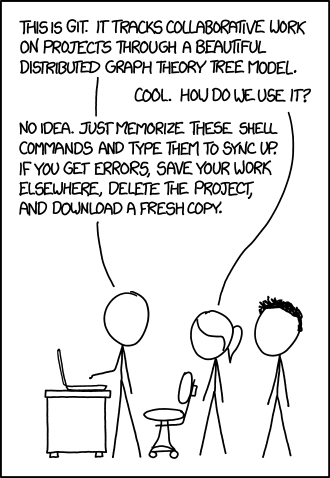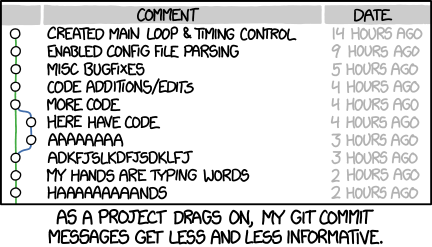Intro to Git
Why learn git?
My software never has bugs.
It just develops random features.


http://explainxkcd.com/wiki/index.php/1597:_Git
So what is it?
Git is a distributed version control system that was made with an emphasis on performance
(speed and data integrity)
Agenda
-
Install
-
Review basic commands
-
2 more commands
-
Git workflows
-
Hands on
Install git
Windows
- Install git (with bash)
https://git-scm.com/download/win - Install Cmder
https://github.com/cmderdev/cmder - Install Cygwin
https://cygwin.com/install.html
Mac
Comes pre-installed
Linux
Should come pre-installed
- Debian-based
sudo apt-get install git-all - Fedora variant
sudo yum install git-all
Initialize repository
$ git init [project-name]
creates a new Git repository
* if repo does not already exist
re·pos·i·to·ry
noun
- a place, building, or receptacle where things are or may be stored.
-
COMPUTING
a central location in which data is stored
and managed.
"the metadata will be aggregated in a repository"
git remote
Connects your local repository to a remote instance
(eg. Github, BitBucket, personal)
* if repo does not already exist
$ git remote add origin [url]
git clone
Copies existing repository files to your machine
NOTES:
- Will create a new folder with the repo's name
- Requires an existing repo
$ git clone [url]

Adding & Removing Files
Add or remove files to a
"staging index" for commiting
$ git add [file]
$ git rm [file]
$ git add .
Shortcut to add all
changed files
Question:
why use instead of ?
git add . git add *
To be answered later...
$ git commit -m "[message]"
Commit your changes
Saves a snapshot of the changes ("delta")
made to your files and when.
The message should be relevant and significant.
C0
C1
A Visualization

https://explainxkcd.com/wiki/index.php/1296:_Git_Commit
Ignore some stuff
Let git forget about and ignore non-critical files.
$ touch .gitignore
$ git add .gitignore
$ git commit -m "Add gitignore"
What is non-critical?
- development config files
- log files
- 'secret' files
- mock data

- thumbnails
-
Thumbs.db, .DS_Store, ._*
-
- IDE config files
-
*.sublime-workspace, *.idea/
-
Question:
why use instead of ?
git add . git add *
The latter does not respect the .gitignore!
Push your changes
Update remote repo with associated changes
$ git push
Push implicitly points to master
You could specify where to point your changes to
$ git push origin master
$ git push -u origin otherremote
but you probably will never need to.
Get what has changed
This changes your local files.
$ git pull
implicitly does a and then
git pull git fetch git merge
Check what has changed
Reports what changes have been made to the remote.
This does not change your local files.
$ git fetch
Branch out
Branch early, and branch often!
$ git branch new-branch-name
Simply points to a specific commit from history.
Default branch is called
master
$ git branch -b newbranch
is shorthand for
$ git branch newbranch
$ git checkout newbranch
checkout switches to the specified branch and updates the working directory
C0
A Visualization
C1
C2
B1
Merge back in
$ git merge other-branch
Simply points to a specific commit
Create a new branch, develop a new feature,
and combine it back in

C0
A Visualization
C1
C2
C3
B1
But... not everything
goes smoothly
$ git merge other-branch
If the same part of the same file changed differently in the two branches being merged, Git can't merge them cleanly

Merge conflicts need to
be resolved
Git adds conflict-resolution markers so you can identify
them and manually resolve those conflicts
<<<<<<< HEAD:index.html
<div id="footer">contact : support@email.com</div>
=======
<div id="footer">
please contact us at support@email.com
</div>
>>>>>>> newbranch:index.htmlMerge conflicts need to
be resolved
Once resolved, simply commit to finish the merge...
<div id="footer">contact us at support@email.com</div>$ git commit
Merge branch 'newbranch'
Conflicts:
index.html
#
# It looks like you may be committing a merge.
# If this is not correct, please remove the file
# .git/MERGE_HEAD
# and try again.
# Please enter the commit message for your changes. Lines starting
# with '#' will be ignored, and an empty message aborts the commit.
# On branch master
# All conflicts fixed but you are still merging.
#
# Changes to be committed:
# modified: index.html
#
2 more commands
$ git status
$ git diff [file]
Lists all new or modified files to be commited
Shows file differences not yet staged
Part II
Workflow strategies
Trunk
Feature Branch
master
feature
master
feature 1
feature 2
master
feature 1
feature 2
Protip: Merge master into feature, and then feature back to master.
Gitflow
master
develop
hotfix
release
feature
1.0.0
1.0.1
1.1.1
New repo
-
git init
-
git remote add https://...
-
git add .
-
git commit -m "msg"
Existing repo
-
git clone https://...git
- Make some change to a file
-
git add .
-
git commit -m "msg"
Hands on
Git config
$ git config --global user.name "John Doe"
$ git config --global user.email "e@mail.co"
Additional Practice
- https://www.codecademy.com/learn/learn-git
- https://try.github.io/
Resources
- https://git-scm.com/doc
- https://www.pluralsight.com/courses/git-fundamentals